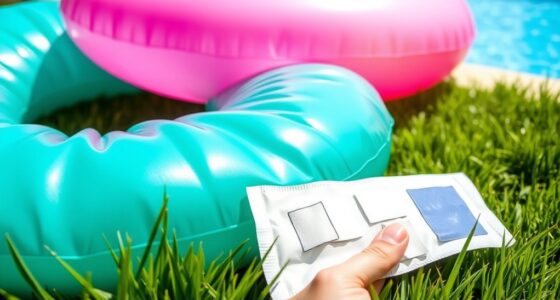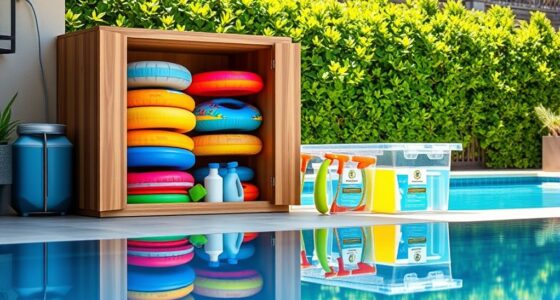To combine floating and kayaking safely, always wear a properly fitting life jacket, and keep it on throughout your activity. Check the weather forecast beforehand and stay alert for sudden changes like storms or high winds. Know your waterway and stick to safe zones, avoiding strong currents or heavy boat traffic. Carry waterproof communication tools and stay close to shore for quick access to help. Continue exploring safety tips to ensure a fun and secure experience on the water.
Key Takeaways
- Always wear a properly fitting life jacket suitable for both floating and kayaking activities.
- Check weather conditions carefully and postpone if storms, high winds, or drops in temperature occur.
- Plan your route to stay close to shore, avoiding strong currents and heavy boat traffic.
- Carry waterproof communication devices like whistles or cell phones for emergencies.
- Continuously monitor weather and water conditions, remaining alert to sudden changes to ensure safety.

Floating and kayaking can be a fun way to explore waterways, but combining these activities safely requires proper planning and awareness. When you’re switching between floating on a tube or raft and paddling a kayak, your safety depends on knowing how to prepare and react to changing conditions. One of the most important safety tools you should always have with you is a life jacket. Whether you’re floating lazily or actively paddling, wearing a life jacket ensures that if you fall into the water unexpectedly, you stay afloat and avoid panic. Choose a life jacket that fits well and is approved for water activities, as a poorly fitting one can hinder your ability to move or breathe comfortably. Keep it on at all times, regardless of your confidence or swimming skills, because accidents happen suddenly and without warning.
Weather awareness is another critical aspect when combining floating and kayaking. Before heading out, check the weather forecast thoroughly. Sudden storms, high winds, or rapid temperature drops can turn a peaceful day into a dangerous situation. If you notice darkening skies, increasing wind speeds, or a sudden drop in temperature, it’s best to postpone your trip. During your outing, stay alert to weather changes and be ready to act quickly. Wind can shift water conditions, making paddling more difficult or pushing your floating device away from your starting point. Rain can reduce visibility and make surfaces slippery, while lightning poses an immediate hazard that requires you to seek shelter. Always keep an eye on the sky and listen for weather alerts, especially if you’re in open water. Additionally, understanding water chemistry and surface conditions can help you anticipate and respond to changing water safety hazards.
In addition to wearing your life jacket and monitoring weather, plan your route carefully. Know the waterway, identify safe entry and exit points, and avoid areas with strong currents or boat traffic. Carry a waterproof communication device, like a cell phone or a whistle, to call for help if needed. Staying close to the shore or designated safe zones makes it easier to reach safety quickly. Remember, combining floating and kayaking is about enjoying the water responsibly. By wearing your life jacket, keeping weather awareness at the forefront, and planning your trip intelligently, you substantially reduce risks and ensure a fun, safe experience on the water.
Frequently Asked Questions
Can Beginners Safely Try Both Activities Together?
Yes, beginners can safely try both activities together if you follow proper safety precautions and understand the skill requirements. Start with a guided tour or lessons from experienced instructors to learn essential techniques. Always wear a life jacket, check weather conditions, and stay within your comfort zone. By taking these steps, you’ll reduce risks and enjoy a fun, safe experience combining floating and kayaking.
What Gear Is Essential for Combining Floating and Kayaking?
You’ll need essential safety gear like a well-fitting life jacket and a helmet, regardless of your skill level. Wearing a wetsuit can provide extra warmth and protection. Always carry a whistle for signaling and a waterproof bag for valuables. Your skill level determines the gear sophistication; beginners should prioritize safety gear and basic paddling equipment. Proper gear guarantees you stay safe, comfortable, and confident while combining floating and kayaking activities.
How to Handle Sudden Weather Changes During Combined Activities?
When sudden weather changes occur, stay calm and prioritize weather awareness. Quickly assess if conditions are worsening, and head to shore if necessary. Always carry emergency preparedness gear, like a waterproof radio, whistle, and extra clothing. Keep an eye on the sky, monitor weather updates, and have a plan for quick evacuation. By staying alert and prepared, you can handle unexpected weather shifts safely during your floating and kayaking adventures.
Are There Age Restrictions for Combining Floating and Kayaking?
Age restrictions for combining floating and kayaking vary depending on the activity and location, but “you’re never too old to learn” still applies. Generally, safety guidelines recommend children be at least 5-7 years old with adult supervision. Always check local regulations and equipment requirements for specific age limits. Prioritize safety, follow guidelines, and guarantee everyone understands basic water safety to enjoy your adventure responsibly.
What Are Common Mistakes to Avoid When Combining These Activities?
You should avoid rushing into combining floating and kayaking without a proper risk assessment. Always check water safety conditions beforehand, like currents, weather, and water levels. Don’t ignore your skill level or underestimate the difficulty, and avoid overcrowding or overloading your kayak. Make sure everyone wears life jackets and stays within designated areas. Staying alert and prepared helps prevent accidents and makes your experience safer and more enjoyable.
Conclusion
Now that you know how to safely combine floating and kayaking, you’ll enjoy your adventures even more. Remember to always wear your life jacket, stay alert to your surroundings, and respect the water. With preparation and caution, you can have fun while staying safe. So, are you ready to explore the water confidently and make unforgettable memories? Get out there, stay safe, and embrace the thrill of your next aquatic adventure!










